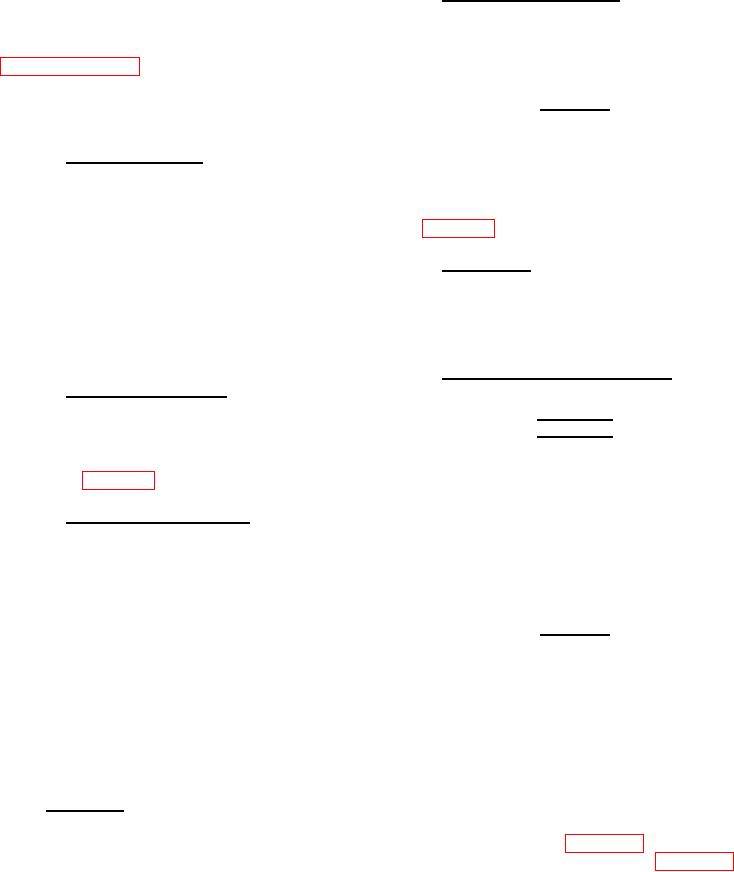
NAVAIR 01-1A-509-3
01 March 2005
TM 1-1500-344-23-3
TO 1-1-689-3
2-5.3.12.4. Rinse with clean, fresh water and by area
2-6.2. DRYING PREPARATION. Prior to placing a
with Cleaning Cloth, CCC-C-46.
component in a drying oven, remove all covers, lids,
and open all doors. Ensure any pressure sensitive
2-5.3.12.5. Remove grease and oil as specified in
tape and protective plastic bags used during the
paragraph 2-5.3.12.1. Use a solution of one part Aircraft
cleaning process have been removed.
Cleaning Compound, MIL-PRF-85570, to ten parts of
distilled water. Air Force may use MIL-PRF-87937
CAUTION
Type II or IV as an alternate cleaning compound.
The motion of air against other materials can
2-5.3.13. Surface Preparation. The true cleanliness of
generate static charges that degrade or destroy
bare metal surfaces after a cleaning process is very
ESD devices. Care must be exercised during
critical to adhesion of any subsequent coating material.
handling/repair of these items. Use the
For example, a chemical conversion coating, paint, dry
recommended shop practices outlined in
film lubricant, or adhesive needs a clean surface to
adhere properly. One method used to identify when a
surface is clean enough for good adhesion is the
2-6.3. AIR DRYING. Air drying is usually adequate for
Water Break Test. The procedure is described in
housings, covers, and some hardware. This method is
Volume II (Navy and Army) and TO 1-1-691 (Air Force).
not considered adequate for more complex equipment
This test is appropriate for use at the time of the final
or components that may contain cavities or moisture
clear water rinse. This usually follows cleaning of any
traps.
bare metal surface for adhesion.
2-6.4. DRYING WITH HOT AIR BLOWER. Procedures
2-5.3.14. Special Considerations. Dust, fingerprints,
for the use of hot air blowers are as follows:
surface oxides, contaminants, or other foreign material
on a surface, can undo preservation provided by
WARNING
protective coatings. Specific avionic subsystems,
equipment, and components shall be cleaned as
Compressed air used for drying can create
specified in Chapter 6.
airborne particles that may enter the eyes.
Pressure shall not exceed 10 psi. Eye
2-5.3.15. Post-Cleaning Procedures. When aerosol
protection is required.
spray, compressed air, or air from dryers is used on
ESD devices, precautions in NAVAIR 01-1A-23 (Navy)
2-6.4.1. Blow off excess water with dry air or dry
or TO 00-25-234 (Air Force) shall be followed.
nitrogen at not more than 10 psi pressure. Deflect air
off interior back and sides of enclosure to diffuse jet.
2-5.3.15.1. After completion of the cleaning steps,
reinspect the affected area for signs of residue, surface
CAUTION
film, or water.
Portable air blowers, hot air blowers, hair
2-5.3.15.2. If the affected area is not clean, repeat the
dryers, and similar drying devices may cause
c l e a n i n g procedures. Water-displacement,
fires when used in or around aircraft. Hot Air
preservation, and lubrication shall follow the cleaning
Gun, Raychem, HT-900, or an equivalent
and drying steps in preventive maintenance.
spark-proof substitute, is the only authorized
hot air gun to be used in and around aircraft.
2-6. DRYING EQUIPMENT AND PROCEDURES.
Hot Air Gun, A-A-59435, is authorized for shop
use only.
2-6.1. GENERAL. Drying time depends on the
complexity of the equipment/component being dried.
2-6.4.2. Dry the equipment with a Hot Air Gun, A-A-
The more complex the individual component, the longer
59435 (Volume IV or V, Chapter 3), or Hot Air Gun,
the drying time. Another consideration in drying time is
Raychem, HT-900 (Volume IV or V, Chapter 3), as
the humidity or moisture content of the air where the
appropriate. Surfaces should not be heated with the
drying oven is operated. The higher the moisture
hot air gun above 130F when drying equipment.
content of ambient air, the longer the drying time.

